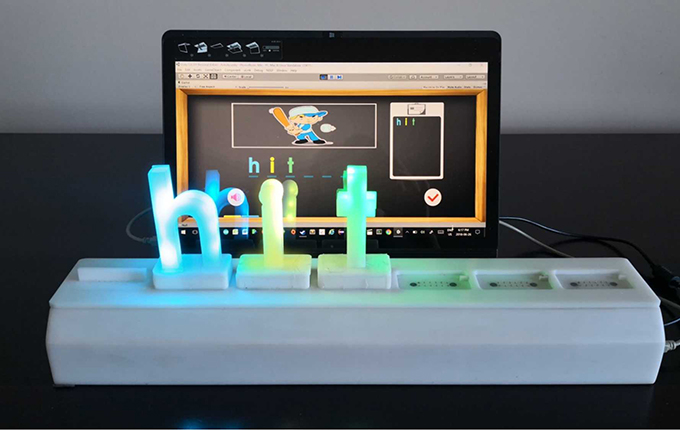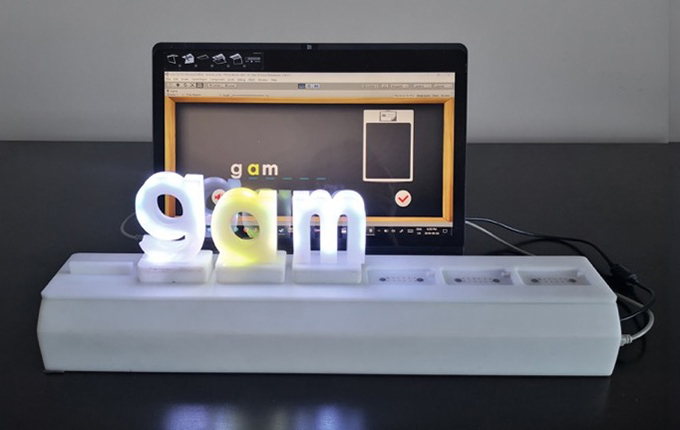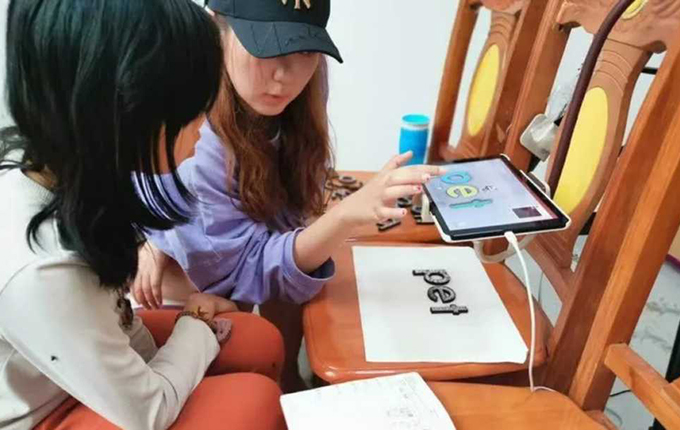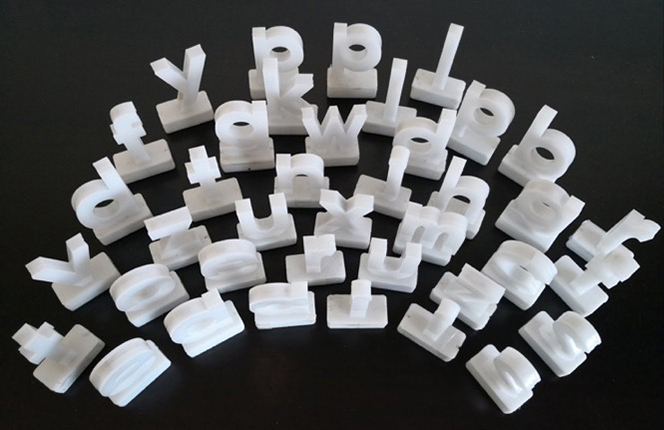PhonoBlocks
Tangible and AR reading systems supporting children at-risk for dyslexia
Introduction
- Dyslexia is a specific learning difficulty that affects individuals’ language-acquisition skills, such as learning to read and spell. Approximately 10% of children in English-speaking countries are diagnosed as dyslexia. with PhonoBlocks, we aimed to explore the design space of tangible and AR reading systems to support children at-risk for dyslexia to learn to read and spell.
- Based on theories regarding the causes of dyslexia, best practices of multisensory instruction, and TUI research, we proposed the design of PhonoBlocks, a tangible reading system support children aged 7-9 in learning the alphabetic principle. The two core design features of our system are (1) embedded dynamic colour cues that draw children’s attention to letter-sound correspondences and explicitly highlight moments of letter sound changes, and (2) 3D tangible letters with hard edges that facilitate letter manipulation and tracing activities.
- We conducted two case studies with monolingual English-speaking children aged 7-8 at an urban public elementary school in Canada and identified the system’s potential in supporting alphabetic learning for children at-risk for dyslexia who have poor phonological awareness. This motivated us to introduce the system to children who are learning English as a foreign language (EFL), as many of them may also struggle with poor phonological awareness and face difficulties in learning English. Theses case studies demonstrated significant learning gains for the children compared to their baseline performance. Additionally, our qualitative analysis of the children’s interaction with the system suggests that the core design features of TUIs positively influenced learning outcomes.
- To enhance accessibility, we subsequently designed and implemented a similar AR version of PhonoBlocks. We not only explored the technical solutions but also investigated how the AR system could be used by children and teachers’ use in a rural school setting. We summarized several interesting learning behaviors exhibited by rural children and identified the opportunities and challenges associated with using the system in the rural context.
Pictures & Videos




播放视频
Papers and Awards
- Fan, M.*, Antle, A.N., Warren, J. Augmented Reality for Early Language Learning: A Systematic Review of AR Application Design, Instructional Strategies, and Evaluation Outcomes. Journal of Educational Computing Research.2020;58(6):1059-1100.
- Fan, M.*, Antle, A.N., Maureen, H. Neustaedter, C. Cramer, E.S. Why Tangibility Matters: A Design Case Study of At-Risk Children Learning to Read and Spell. In Proceedings of Conference on Human Factors in Computing Systems (CHI ‘17), ACM Press, Denver, USA, May 6-11, 2017, 1805-1816. (Top 5% Honorable Mention Award)
- Fan, M.*, Antle, A.N., Maureen, H. Neustaedter, C. Evaluating PhonoBlocks: A Tangible System Supported for Young English Language Learners. International Journal Child-Computer Interaction.18 (2018), 67-78.
- Fan, M.*, Antle, A.N. An English Language Learning Study with Rural Chinese Children Using an Augmented Reality App.Proceedings of Conference on Interaction Design and Children (IDC’20), ACM Press, London, UK, June 21-24, 2020, 385-397.
- Fan, M.*, Antle, A.N., Cramer, S. Emily. Design Rationale: Opportunities and Recommendations for Tangible Reading Systems for Children. In Proceedings of Conference on Interaction Design for Children (IDC ‘16), ACM Press, Manchester, UK, June 21-24, 2016, 102-112.
- Fan, M.*, Antle, A.N., Sarker, S. From Tangible to Augmented Reality: Designing a PhonoBlocks Reading System Using Everyday Technologies. In Extended Abstracts of Proceedings of Conference on Human Factors in Computing Systems (CHI’ EA 18), ACM Press, Montreal, April 21-16, 2018, LBW555, 1-4.
- Fan, M.*, Antle, A.N., Cramer, S. Emily. Exploring the Design Space of Tangible Systems Supported for Early Reading Acquisition in Children with Dyslexia. In Proceedings of Conference on Tangible, Embodied and Embedded Interaction (TEI’16), ACM Press, Eindhoven, the Netherlands, February 14-17, 2016, 690-692.
- Fan, M.*, Jin, S., Antle, A.N. Designing Colour and Materials in Tangible Reading Products for Foreign Language Learners of English. In Extended Abstracts of Proceedings of Conference on Human Factors in Computing Systems (CHI’ EA 18), ACM Press, Montreal, April 21-16, 2018, LBW526, 1-4.
- Fan, M.*, Antle, A.N. Tactile Letters: A Tangible Tabletop with Texture Cues Supporting Alphabetic Learning for Dyslexic Children. In Proceedings of Conference on Tangible, Embodied and Embedded Interaction (TEI’15), ACM Press, Stanford, CA, USA, January 16-19, 2015, 673-678.
- Fan, M.*, Baishya, U., Mclaren, E., Antle, A.N., Sarker, S., Vincent, A. Block Talks: A Tangible and Augmented Reality Toolkit for Children to Learn Sentence Construction. In Extended Abstracts of Proceedings of Conference on Human Factors in Computing Systems (CHI’ EA 18), ACM Press, Montreal, April 21-16, 2018, LBW056, 1-4.
- Antle, A.N., Fan, M.*, Cramer, E.S. PhonoBlocks: A Tangible System for Supporting Dyslexic Children Learning to Read. In Proceedings of Conference on Tangible, Embodied and Embedded Interaction (TEI’15), ACM Press, Stanford, CA, USA, January 16-19, 2015, 533-538.
- Cramer, E.S., Antle, A.N., Fan, M.The Code of Many Colours: Evaluating the Effects of a Dynamic Colour-Coding Scheme on Children’s Spelling in a Tangible Software System. In Proceedings of Conference on Interaction Design for Children (IDC ‘16), ACM Press, Manchester, UK, June 21-24, 2016,473-485.
- Cramer, E.S., Antle, A.N., Fan, M. Colouring the Path from Instruction to Practice: Perspectives on Software for Struggling Readers. In Proceedings of Conference on Interaction Design for Children (IDC ‘15), ACM Press, Medford, MA, USA, June 21-25, 2015, 331-334.
- Best Demo Award in 2018 UBC Design and Demo Showcase
